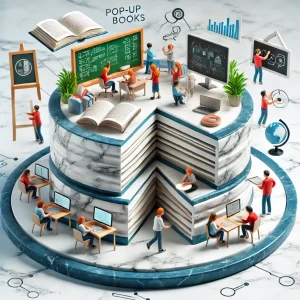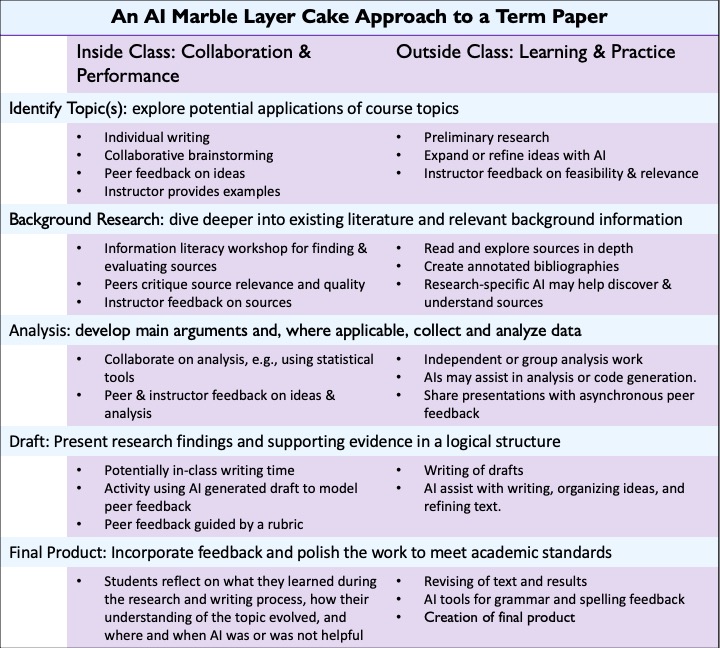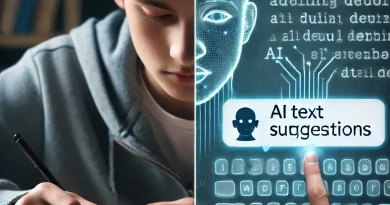Part 2: The AI Marble Layer Cake – Reconsidering In-Class and Out-of-Class Learning & Assessment
by Carie Cardamone, Associate Director for STEM, Professional Schools & Assessment
This is Part 2 of the series Addressing Academic Integrity in the Age of AI
In Part 1: Beyond AI Detection – Rethinking Academic Assessments, we explored ways to foster authentic student engagement in their learning and reduce incentives for academic dishonesty. In Part 2, let’s dive deeper into an example approach to course design that addresses these challenges head-on by reimagining the structure of our courses. Drawing on the science of learning, we propose the AI Marble Layer Cake approach to designing a learning environment resistant to AI misuse.
The Traditional Model and Its Vulnerabilities
One nearly universal assumption in course design is that students will complete much of their work independently, outside the classroom. This traditional assessment model serves two purposes:
- Foster genuine learning: Independent work promotes the time and effort required for deep, durable learning. It also provides insights into the students’ learning progress, that can generate feedback to help direct future learning efforts.
- Accurately measuring students’ independent capabilities: It produces artifacts (e.g. assessments or other work) that instructors can evaluate and grade.
However, this common practice creates assessments with a confluence of factors particularly susceptible to AI misuse, including:
- Difficulty: For novice learners, these independent tasks can be challenging, time-consuming, and lead to uncertainty about their ability to succeed.
- Time Pressure: Students frequently complete these activities under tight deadlines, balancing multiple courses, extracurricular activities, work and family commitments.
- External motivation: Assessments often focus students on extrinsic factors such as course completion or grade attainment, rather than a perceived intrinsic value in the learning process.
- AI advantage: Students proficient with advanced generative AI systems can leverage these tools to produce high-quality work more quickly and with less effort, often unaware when they are bypassing the intended learning process. Conversely, students without literacy in AI can also feed most assignments directly into a generative AI system which will quickly produce an artifact, but often one of a much lower quality and authenticity that can be more easily identified by an instructor.
As a result, instructors are increasingly finding that their existing assessment methods are falling short of their dual purposes: fostering genuine learning and accurately measuring students’ independent capabilities. To address the vulnerabilities of traditional assessment methods, we need to reconceptualize where learning and assessment happen throughout a course.
Introducing the AI Marble Layer Cake Approach
The AI Marble Layer Cake proposes a shift in course structure: Outside of class time is dedicated to learning and practice, while inside class time prioritizes collaboration and performance. This builds on the ‘flipped classroom’ concept, integrating AI-assisted learning where appropriate and emphasizing real-time and human-connected demonstrations of knowledge and skills. In this model students can engage with a variety of learning materials (readings, videos, podcasts) and complete practice exercises or preparatory activities at their own pace outside of the classroom. Then inside-of-class-time is dedicated to formative assessments, collaborative work, discussions, peer feedback, presentations, and other summative assessments. This restructuring serves multiple purposes:
- It provides students with the flexibility to self-pace their engagement with new information outside of class and independently prepare-for and follow-up-on in class activities.
- It leverages classroom time for human connections, fostering collaborative learning and real-time feedback on their ideas.
- It creates opportunities for authentic in-class assessments that are less susceptible to misuses of AI.
- It provides the instructor with opportunities to guide student progress through real-time feedback during class, written comments on assignments, and depending on the course size and structure, one-on-one or group conversations during in class activity time.
- Specific activities guiding the students’ engagement with AI both inside and outside the classroom can support student’s learning, AI-literacy and to prepare for real-world disciplinarily appropriate uses of AI.
By interweaving in-class activities and out-of-class learning with a marble swirl of independent work, peer collaboration, instructor feedback, and even guided AI engagement, we create a “layered” approach to learning – hence, the Marble Layer Cake metaphor.
Practical Application: Reimagining the Term Paper
To illustrate the AI Marble Layer Cake course design approach in action, let’s reimagine a traditional end-of-semester term paper assignment that represents a culmination of the students learning throughout the class. We selected this example to demonstrate how one can transform a typically solitary, out-of-class task into a rich, layered learning experience that leverages continuous in-class and out-of-class engagement throughout a semester.
We begin by distributing the assignment in scaffolded stages throughout the semester, refocusing students on the process rather than a single product turned in at the end. Each of these stages builds on the results of the other, and asks students to work both independently and collaboratively. This approach allows for multiple touchpoints for learning, feedback, and assessment. In the table below, students bring work generated independently outside of the classroom into a subsequent class to build on it and/or receive live peer feedback.
At each stage of the student’s work, clearly identifying the appropriate level and methods of AI use is essential. When considering requiring that all students use AI, note that some students might have ethical and privacy objections towards using AI. This Final Project: A Reading Portfolio by Jason Gulya in Writing Through Lit 1 demonstrates a range of uses of AI – from prohibited, to optional, to required.
In Conclusion: Advantages of the AI Marble Layer Cake Approach
The AI Marble Layer Cake approach represents a paradigm shift in how we structure courses and assessments in higher education. By reimagining traditional assignments like term papers, we can create a learning environment that is more resistant to AI misuse while simultaneously enhancing the quality and depth of student learning. This model not only addresses some of the challenges posed by AI, it also aligns with research-based principles of effective learning. Distributing the learning process throughout the semester, promotes deeper understanding over time. The in-class activities and real-time demonstrations of knowledge makes it more challenging to rely solely on AI-generated content. Multiple touchpoints for feedback and revision lead to improved skill development, encourages students to engage in social learning. The scaffolding approach also helps encourage consistent engagement with course materials and avoid cramming. Students explore using AI as a tool for enhancement rather than replacement of their own work preparing students for a future where AI tools may be an integral part of professional and academic work. By teaching students how to effectively and ethically integrate AI into their learning process, we equip them with valuable skills for their future careers.
Acknowledgement: The AI Marble Layer Cake idea was inspired by the AI Sandwich by Jon Ippolito and conversations on POD’s AI in Education listserv.
Return to the series Addressing Academic Integrity in the Age of AI






